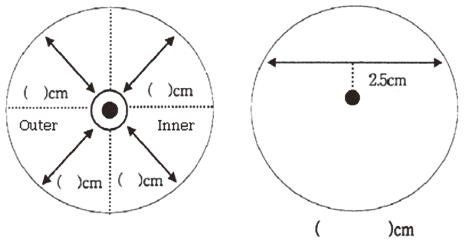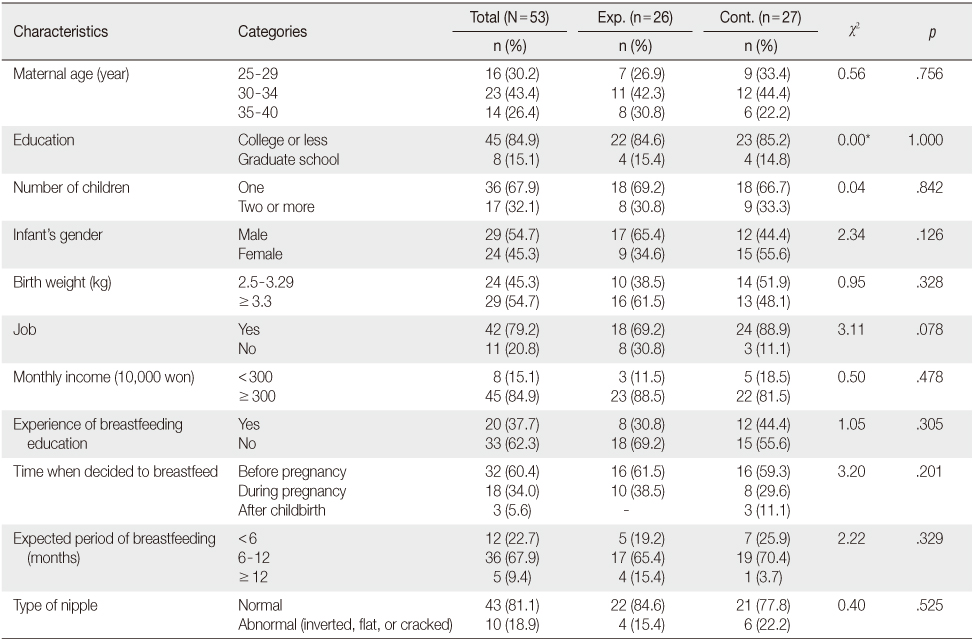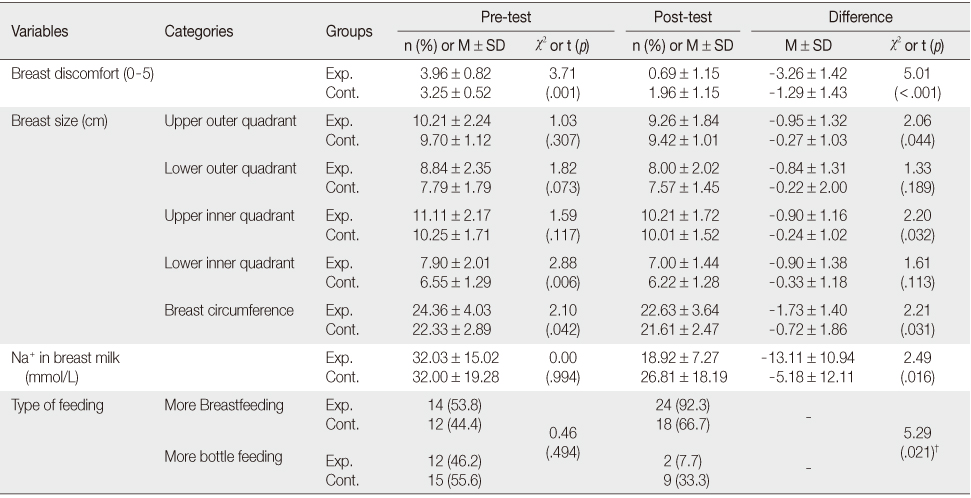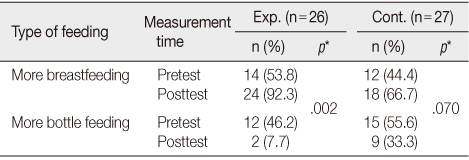Articles
- Page Path
- HOME > J Korean Acad Nurs > Volume 44(2); 2014 > Article
-
Original Article
- Development and Evaluation of Breastfeeding Promotion Program for Mothers with Breast Engorgement following Cesarean Birth
- Jeongsug Cho, Sukhee Ahn
-
Journal of Korean Academy of Nursing 2014;44(2):170-178.
DOI: https://doi.org/10.4040/jkan.2014.44.2.170
Published online: April 30, 2014
1Academy of Oketani Breast Management, Seoul, Korea.
2College of Nursing, Chungnam National University, Daejeon, Korea.
- Address reprint requests to: Ahn, Sukhee. College of Nursing, Chungnam National University, 266 Munwha-ro, Jung-gu, Daejeon 301-747, Korea. Tel: +82-42-580-8324, Fax: +82-42-580-8309, sukheeahn@cnu.ac.kr
© 2014 Korean Society of Nursing Science
This is an Open Access article distributed under the terms of the Creative Commons Attribution NoDerivs License. (http://creativecommons.org/licenses/by-nd/4.0/) If the original work is properly cited and retained without any modification or reproduction, it can be used and re-distributed in any format and medium.
Abstract
-
Purpose
- This study was to develop a breastfeeding promotion program and to test effects of the program on levels of breast discomfort, breast size, sodium in breast milk, and type of feeding in mothers with breast engorgement following cesarean birth.
-
Methods
- A non-synchronized non-equivalent control group pretest-posttest design was used in this study. The participants were 70 postpartum mothers who were admitted to a postpartum care center and experienced breast engorgement following cesarean birth. The planned nursing intervention was the breastfeeding promotion program consisting of breast massage and 1:1 breastfeeding education, counseling, and support focusing on individualized problem solving provided for 10 days. Fifty-three women completed the program (experimental group 26, control group, 27). Measurements were level of breast discomfort, breast size, sodium in breast milk and type of feeding at pre and posttest.
-
Results
- Women who participated in the program experienced lower scores for breast discomfort, greater decrease in breast size, lower levels of sodium in breast milk, and practiced breastfeeding more than those in the control group.
-
Conclusion
- Results indicate that this breastfeeding promotion program is effective in reducing breast engorgement and improving breastfeeding practices, and is therefore recommended to enhance breastfeeding promotion practice in postpartum care centers.
This manuscript is a condensed form of the first author's doctoral dissertation from Chungnam National University.
- 1. World Health Organization. Infant and young child feeding: Model chapter for textbooks for medical students and allied health professionals. Geneva, CH: World Health Organization; 2009.
- 2. Thulier D, Mercer J. Variables associated with breastfeeding duration. J Obstet Gynecol Neonatal Nurs. 2009;38(3):259–268. http://dx.doi.org/10.1111/j.1552-6909.2009.01021.xArticlePubMed
- 3. Kim SK, Kim YK, Kim HR, Park JS, Son CK, Choi Y, et al. Report No.: Research Paper 2012-54. The 2012 national survey on fertility, family health & welfare in Korea. Seoul: Korea Institute for Health and Social Affairs; 2012.12.
- 4. Jang GJ, Kim SH. Effects of breast-feeding education and support services on breast-feeding rates and infant's growth. J Korean Acad Nurs. 2010;40(2):277–286. http://dx.doi.org/10.4040/jkan.2010.40.2.277ArticlePubMed
- 5. Lee SO, Chung ES, Ahn SH, Moon GN, Park NH. A study of predictors of breastfeeding. Korean J Child Health Nurs. 2003;9(4):368–375.
- 6. Eum GR, Sohn HS, Kim HY. Breastfeeding rate and related factors in Busan. J Korean Soc Matern Child Health. 2007;11(1):78–85.Article
- 7. Zanardo V, Svegliado G, Cavallin F, Giustardi A, Cosmi E, Litta P, et al. Elective cesarean delivery: Does it have a negative effect on breastfeeding? Birth. 2010;37(4):275–279. http://dx.doi.org/10.1111/j.1523-536X.2010.00421.xArticlePubMed
- 8. Evans KC, Evans RG, Royal R, Esterman AJ, James SL. Effect of caesarean section on breast milk transfer to the normal term newborn over the first week of life. Arch Dis Child Fetal Neonatal Ed. 2003;88(5):F380–F382.ArticlePubMedPMC
- 9. Shawky S, Abalkhail BA. Maternal factors associated with the duration of breast feeding in Jeddah, Saudi Arabia. Paediatr Perinat Epidemiol. 2003;17(1):91–96.ArticlePubMed
- 10. Cakmak H, Kuguoglu S. Comparison of the breastfeeding patterns of mothers who delivered their babies per vagina and via cesarean section: An observational study using the LATCH breastfeeding charting system. Int J Nurs Stud. 2007;44(7):1128–1137. http://dx.doi.org/10.1016/j.ijnurstu.2006.04.018ArticlePubMed
- 11. Mass S. Breast pain: Engorgement, nipple pain and mastitis. Clin Obstet Gynecol. 2004;47(3):676–682.ArticlePubMed
- 12. Cho J, Ahn HY, Ahn S, Lee MS, Hur MH. Effects of oketani breast massage on breast pain, the breast milk pH of mothers, and the sucking speed of neonates. Korean J Women Health Nurs. 2012;18(2):149–158. http://dx.doi.org/10.4069/kjwhn.2012.18.2.149ArticlePubMed
- 13. Kim EK. Physiology of lactation. Hanyang Med Rev. 2010;30(1):1–7. http://dx.doi.org/10.7599/hmr.2010.30.1.1Article
- 14. Neville MC, Morton J, Umemura S. Lactogenesis. The transition from pregnancy to lactation. Pediatr Clin North Am. 2001;48(1):35–52.PubMed
- 15. Hsien CF, Fu JC, Long CY, Lin HS. Factors influencing breast symptoms in breastfeeding women after cesarean section delivery. Asian Nurs Res. 2011;5(2):88–98.Article
- 16. Neville MC. Introduction: Tight junctions and secretory activation in the mammary gland. J Mammary Gland Biol Neoplasia. 2009;14(3):269–270. http://dx.doi.org/10.1007/s10911-009-9150-8ArticlePubMedPDF
- 17. Oketani Lactation Management Association. Oketani lactation management: Japanese breast massage manual. Tokyo, JP: Oketani Lactation Management Association; 2004.
- 18. Morton JA. The clinical usefulness of breast milk sodium in the assessment of lactogenesis. Pediatrics. 1994;93(5):802–806.ArticlePubMedPDF
- 19. Humenick SS, Hill PD, Thompson J, Hart AM. Breast-milk sodium as a predictor of breastfeeding patterns. Can J Nurs Res. 1998;30(3):67–81.
- 20. Becker GE, Cooney F, Smith HA. Methods of milk expression for lactating women. Cochrane Database Syst Rev. 2011;12:CD006170. http://dx.doi.org/10.1002/14651858.CD006170.pub3Article
- 21. Ahn S, Kim J, Cho J. Effects of breast massage on breast pain, breast-milk sodium, and newborn suckling in early postpartum mothers. J Korean Acad Nurs. 2011;41(4):451–459. http://dx.doi.org/10.4040/jkan.2011.41.4.451ArticlePubMed
- 22. Lee JA, So JS, Kim MJ, Na HN, Kim MH, Seo MS, et al. Reduction for incidence rate of breast engorgement in women with cesarean birth. In: The 2010 Fall Conference of the Korean Society of Quality Assurance in Health Care; 2008 December 4-5; BEXCO Convention Hall. Busan, The Korean Society of Quality Assurance in Health Care; 2008. p. 106–108.
- 23. Yun SE, Lee HK. Effects of breast-feeding adaptation, attitude and practice of primipara depending on method of postpartum breast-feeding education. Korean J Women Health Nurs. 2012;18(2):75–84. http://dx.doi.org/10.4069/kjwhn.2012.18.2.75ArticlePubMed
- 24. Park YR. The effects of the integrated breast-feeding education on the knowledge, the adhesiveness and the attitude on breast-feeding [master's thesis]. Incheon, Inha University. 2005.
- 25. Cohen J. Statistical power analysis for the behavioral sciences. 2nd ed. Hillsdale, NJ: Lawrence Erlbaum Associates; 1988.
- 26. Walker M. Breastfeeding and engorgement. Breastfeed Abstr. 2000;20(2):11–12.
- 27. Jung SH. The change of breast engorgement for non-breast feeding mother after cold cabbage compress [master's thesis]. Gwangju, Chonnam National University. 2004.
- 28. Furman L, Minich N, Hack M. Correlates of lactation in mothers of very low birth weight infants. Pediatrics. 2002;109(4):e57. ArticlePubMedPDF
REFERENCES
Figure & Data
REFERENCES
Citations

- Effect of midwife-led continuity of care combined with individualized breast management on postpartum recovery and lactation function in women undergoing cesarean section
Hua Cai, Yan Lu, Xinyi Kang, Liping Chen
Frontiers in Medicine.2025;[Epub] CrossRef - A randomized controlled trial of pectoralis major myofascial release massage for breastfeeding mothers: breast pain, engorgement, and newborns’ breast milk intake and sleeping patterns
Won-Ryung Choi, Myung-Haeng Hur, Yeon-Suk Kim, Ju-Ri Kim
Korean Journal of Women Health Nursing.2023; 29(1): 66. CrossRef - Effect of aloe vera gel compresses on breast engorgement among postpartum mother
Siti Raihanah, Jasmawati Jasmawati, Nursyahid Siregar
Healthcare in Low-resource Settings.2023;[Epub] CrossRef - Relationship between Selected Trace Elements in Human Milk and Psychosocial Characteristics in Korean Early Postpartum Women
Sookjin Noh, Eunjoo Lee
International Journal of Environmental Research and Public Health.2021; 18(1): 350. CrossRef - The Influence of Knowledge and Health Beliefs about Gestational Diabetes on Breastfeeding Intention of Women with Gestational Diabetes
Seungmi Park, Deulle Min, Jiyeon Park
Journal of Korean Academy of Community Health Nursing.2020; 31(4): 427. CrossRef - A Systematic Review of Breast Care for Postpartum Mothers
Ji-Ah Song, Myung Haeng Hur
Korean Journal of Women Health Nursing.2019; 25(3): 258. CrossRef - Fibroadenoma of bilateral axillary ectopic breast tissue: A rare case report based on Orem’s Self Care theory
G Pinar, H Erbaba
Archives of Nursing Practice and Care.2019; 5(1): 008. CrossRef - Effects of Breastfeeding Interventions on Breastfeeding Rates at 1, 3 and 6 Months Postpartum: A Systematic Review and Meta-Analysis
Seol Hui Park, Seang Ryu
Journal of Korean Academy of Nursing.2017; 47(6): 713. CrossRef - Effects of Boheotang-gagam on Milk Production and Factors Related Lactation in Postpartum Mice
Ah-Yeong Lee, Eun-Hee Lee, Ji-Yeong Im, Hong-Jun Kim, Chang-Hyun Lee
The Journal of Oriental Obstetrics and Gynecology.2016; 29(1): 35. CrossRef - Comparison of Lactation Problems, Knowledge, and Adaptation on Breastfeeding between Users and Non-Users of Lactation Clinic
Myoung Hee Yun, Hye Sook Shin
Journal of East-West Nursing Research.2014; 20(2): 112. CrossRef
- Figure
- We recommend
- Related articles
-
- Development and evaluation of a question-answering chatbot to provide information for patients with coronary artery disease after percutaneous coronary intervention
- The Effects of the Infant Health Promotion Program for Mothers with Their Firstborn Infants
- Development and Evaluation of an App-Based Self-Management Program for Exercise Practice of Breast Cancer Survivors: A Non-Randomized Controlled Trial
- Development and Effectiveness Evaluation of Comprehensive Mobile-Based, Breastfeeding Promotion Program for Mothers with Gestational Diabetes

Figure 1
Breastfeeding Promotion Program for Women with Breast Engorgement following Cesarean Birth
Homogeneity Test for Participants' Characteristics between Experimental and Control Group (N=53)
*Fisher's exact test; Exp.=Experimental group; Cont.=Control group.
Effects of Breastfeeding Promotion Program on Outcome Variables (N=53)
Exp.=Experimental group (n=26); Cont.=Control group (n=27).
†Indicates chi-square test statistics for posttest.
Changes in Type of Feeding between Pretest and Posttest for Each Group (N=53)
*McNemar test; Exp.=Experimental group; Cont.=Control group.
*Fisher's exact test; Exp.=Experimental group; Cont.=Control group.
Exp.=Experimental group (n=26); Cont.=Control group (n=27). †Indicates chi-square test statistics for posttest.
*McNemar test; Exp.=Experimental group; Cont.=Control group.
 KSNS
KSNS
 E-SUBMISSION
E-SUBMISSION





 Cite
Cite

